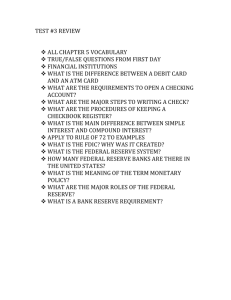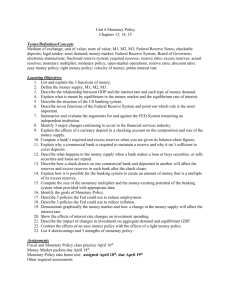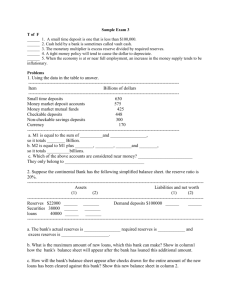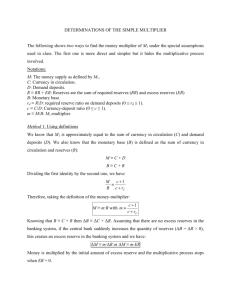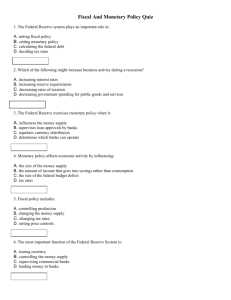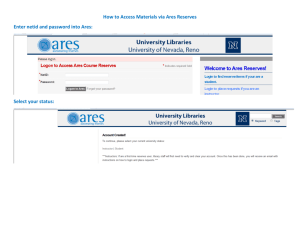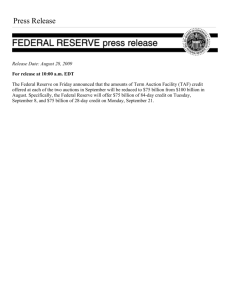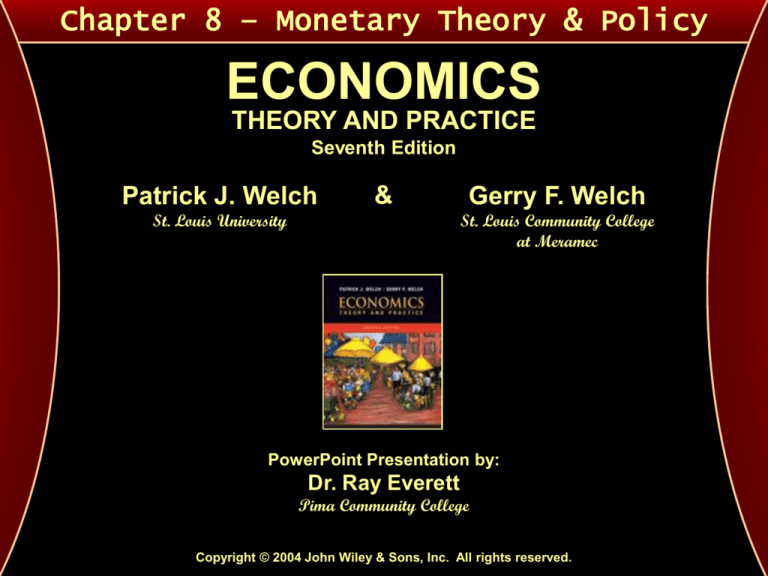
Chapter 8 – Monetary Theory & Policy
ECONOMICS
THEORY AND PRACTICE
Seventh Edition
Patrick J. Welch
&
St. Louis University
Gerry F. Welch
St. Louis Community College
at Meramec
PowerPoint Presentation by:
Dr. Ray Everett
Pima Community College
Copyright © 2004 John Wiley & Sons, Inc. All rights reserved.
Monetary Theory & Policy
Contents
Money Supply & Economics
Money Creation
Interest Rates & Spending Levels
Federal Reserve & Monetary Policy
Monetary Theory & Policy
Chapter Objectives
• To explain the relationship between the economy’s money supply and
output, employment, and prices.
• To explain how money is created and destroyed through the loanmaking activities of financial depository institutions.
• To introduce the multiple expansion of money.
• To explain the role of the interest rate in encouraging or discouraging
borrowing from financial depository institutions.
• To show how interest rates are affected by changes in financial
depository institutions’ excess reserves.
• To define monetary policy and explain the major tools for carrying out
monetary policy by the Federal Reserve.
• To show the relationship between government borrowing to cover
deficit spending and monetary policy.
• To critically evaluate monetary policy.
Money Supply & Economic Activity
• Summary of Key Lessons
Total, or aggregate, spending drives the economy’s levels
of production, employment, and income.
Total spending is found by adding together the spending
of all four major macroeconomic sectors.
Increases in total spending lead to increases in
production, employment, and income unless the
economy is at full employment.
At (or near) full employment, increases in spending lead
to overall price increases or demand-pull inflation.
Decreases in total spending result in a decline in
production, employment, and income, and may dampen
inflation.
Money is created when financial depository institutions
make loans, and it is destroyed when loans are repaid.
8-1a
Money Supply & Economic Activity
• Equation of Exchange
MV = PQ
• Illustrates how changes in the supply of money (M)
influence the level of prices (P) and/or the total output of
goods and services (Q).
• Velocity of money (V) is the number of times each dollar is
spent for new goods and services in a year, or how often
the money supply turns over each year.
• Changing the Money Supply
Increase in money supply (M)
• If not at full employment/production, then (Q) increases
more than (P) increases.
• If at full employment/production, then (P) increases more
than (Q) increases.
Decrease in money supply (M)
• Typically results in a decrease in (Q), but (P) usually does
not decrease.
8-1b
Money Creation
• Process of Money Creation
Actual Reserves
• Financial depository institutions’ reserve account plus its
vault cash.
Reserve Requirement
• Specific percentage of deposits that a financial depository
institution must keep as actual reserves.
Required Reserves
• Amount of actual reserves that a financial depository
institution must keep to back its deposits.
Excess Reserves
• Reserves of a financial depository institution over the
amount it is required to maintain in actual reserves.
– Actual reserves minus required reserves.
8-2a
Money Creation
• Process of Money Creation (cont.)
Excess Reserves & Loan Making
• Depository institutions can make new loans up to the value
of their excess reserves.
8-2b
Money Creation
• Multiple Expansion of Money
Multiplier Effect
• An initial change in excess reserves in the depository
institutions system causes a larger change in the money
supply.
TABLE 8-2
Multiple Expansion of Money (10 Percent Reserve Requirement)
8-2c
Money Creation
• Multiple Expansion of Money (cont.)
Calculating the Money Multiplier
• Use the reciprocal of the reserve requirement.
– 10% reserve requirement = money multiplier of 10
– 20% reserve requirement = money multiplier of 5
Calculating the Total Change in Money Supply
• Multiply the initial change in excess reserves by the money
multiplier, or
– $8,000,000 x 5 = $40,000,000
• Divide the initial change in excess reserves by the reserve
requirement.
– $8,000,000 / 0.20 = $40,000,000
8-2d
Interest Rates & Spending Levels
• Summary of Key Points
TABLE 8-3
Relationship between Loan Making, the Money Supply,
Spending, and the Level of Economic Activity
8-3a
Interest Rates & Spending Levels
• Interest Rate Overview
Interest Rate
• Price paid to borrow money.
– Percentage of the amount borrowed.
• Can be used to control the money supply.
• Determining Interest Rates on Loans
Interest rates for loans are
determined by the demand for and
supply of funds for loans.
Decreases in excess reserves will
cause interest rates to rise and the
amount of loans made to fall.
Increases in the excess reserves will
cause interest rates to fall and the
amount of loans made to rise.
8-3b
Interest Rates & Spending Levels
Determining Interest Rates on Loans (cont.)
FIGURE 8-2
Effect of Changes in Excess Reserves on the
Interest Rate and the Quantity of Loans
8-3c
Interest Rates & Spending Levels
Determining Interest Rates on Loans (cont.)
FIGURE 8-3
Relationship among Excess Reserves, the Interest Rate,
Loan Making, and the Level of Economic Activity
8-3d
Federal Reserve & Monetary Policy
• Monetary Policy Overview
Monetary Policy
• Changing the money supply to influence the levels of
output, employment, and/or prices in the economy.
Easy Money Policy
• Policy by the Federal Reserve to increase excess reserves
of depository institutions in an effort to increase spending
and reduce unemployment.
Tight Money Policy
• Policy by the Federal Reserve to reduce excess reserves of
depository institutions in an effort to reduce spending and
inflationary pressure.
8-4a
Federal Reserve & Monetary Policy
• Monetary Policy Tools
Federal Reserve has three major tools to change excess
reserves in the financial depository institutions system:
• Reserve Requirement
• Discount Rate
• Federal Funds Market
8-4b
Federal Reserve & Monetary Policy
• Monetary Policy Tools (cont.)
Reserve Requirement
• Decreases in the reserve requirement would increase
excess reserves and would be appropriate to stimulate the
economy.
• Increases in the reserve requirement would decrease
excess reserves and would be appropriate to fight demandpull inflation.
8-4c
Federal Reserve & Monetary Policy
• Monetary Policy Tools (cont.)
Discount Rate
• Interest rate that a Federal Reserve Bank charges a
financial depository institution for borrowing reserves.
8-4d
Federal Reserve & Monetary Policy
• Monetary Policy Tools (cont.)
Open Market Overview
• Open Market Operations
– Buying and selling of securities, primarily U.S.
government securities, on the open market by the Federal
Reserve.
• Open Market Committee
– Committee that determines the general policy on Federal
Reserve open market operations.
8-4e
Federal Reserve & Monetary Policy
• Monetary Policy Tools (cont.)
Tools & Policy Objectives
• Expanding the economy requires:
– Buying securities from banks and dealers on the open
market, and/or
– Lowering the reserve requirement, and/or
– Lowering the discount rate
• Fighting demand-pull inflation requires:
– Selling securities to banks and dealers on the open
market, and/or
– Increasing the reserve requirement, and/or
– Increasing the discount rate
8-4f
Federal Reserve & Monetary Policy
• Government Deficits & Monetary Policy
Crowding Out
• Occurs when borrowing by the federal government
increases the interest rate and reduces borrowing by
households and businesses.
Monetizing the Debt
• Increasing the money supply by the Federal Reserve to
accommodate federal government borrowing and reduce
upward pressure on the interest rate.
8-4g
Federal Reserve & Monetary Policy
• Government Deficits & Monetary Policy (cont.)
FIGURE 8-4
Effect of Government Borrowing and Monetizing the Debt
on the Interest Rate and Loan Making
8-4h
Federal Reserve & Monetary Policy
• Advantages & Disadvantages of Monetary Policy
Advantages:
• Quickly implemented in comparison to fiscal policy
• Largely removed from politics
Disadvantages:
• Loan-making link
– Someone must be willing to borrow and a bank must be
willing to lend. The Federal Reserve cannot force the
loan-making process.
• Inflation
– As the money supply is tightened, interest rates increase,
and businesses that borrow at this high rate may raise
prices on their products to compensate.
8-4i
Chapter 8 – Monetary Theory & Policy
This is the end of Chapter 8.
To return to the contents menu of this
chapter, click on the menu graphic to the
right of this text.
To begin Chapter 9, click on the next
chapter icon to the right of this text.
Menu
Next
Chapter
ECONOMICS
THEORY AND PRACTICE
Seventh Edition
Copyright © 2004 John Wiley & Sons, Inc. All rights reserved. Reproduction or translation of this work
beyond that permitted in Section 117 of the 1976 United States Copyright Act without the expressed
written permission of the copyright owner is unlawful. Request for further information should be
addressed to the Permissions Department, John Wiley & Sons, Inc. The purchaser may make back-up
copies for his/her own use only and not for distribution or resale. The Publisher assumes no
responsibility for errors, omissions, or damages, caused by the use of these programs or from the use
of the information contained herein.

